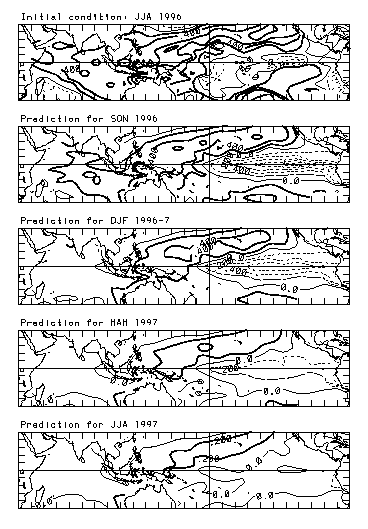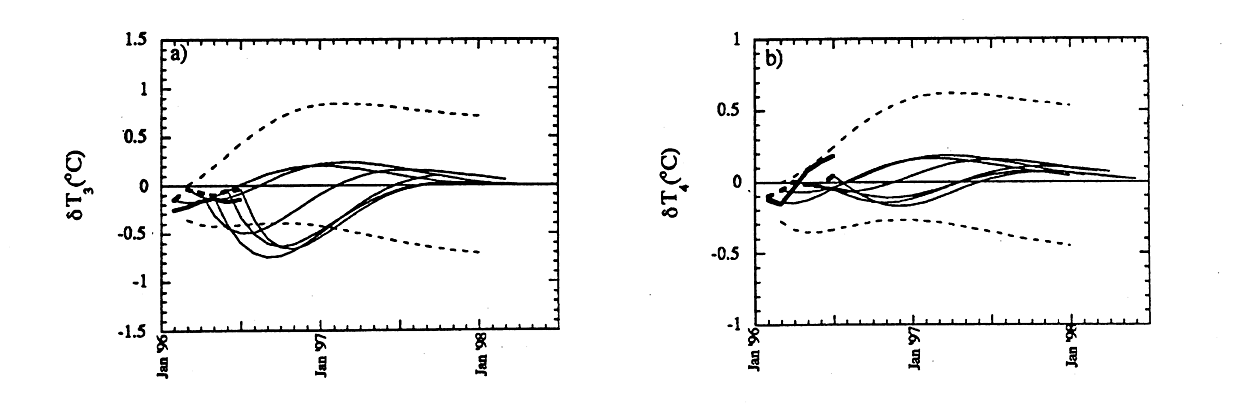
Using the methods described in Penland and Magorian (1993) and in
previous issues of this Bulletin (particularly the December 1992 and June
1993 issues), the pattern of IndoPacific sea-surface temperature anomalies
(SSTAs), the SSTA in the Niño 3 region (6oN-6oS, 90 o-150 oW), and
the SSTA in the Niño 4 region (6oN-6oS, 150 oW-160 oE) are predicted.
A prediction at lead time t is made by applying a statistically-obtained
Green function G(t) to an observed initial condition consisting of SST
anomalies (SSTAs) in the IndoPacific basin. Three-month running means of
the temperature anomalies are used, the seasonal cycle has been removed,
and the data have been projected onto the 20 leading empirical orthogonal
functions (EOFs) explaining about 70% of the variance. The Niño
3 region has an RMS temperature anomaly of about 0.7 oC; the inverse modeling
prediction method has an RMS error of about 0.5oC at a lead time of nine
months and approaches the RMS value at lead times of 18 months to two years.
The COADS 1950-79 climatological annual cycle has been removed.
The predicted IndoPacific SSTA patterns based on the Jun-Jul-Aug 1996 initial
condition for the following Sep-Oct-Nov 1996, Dec-Jan-Feb 1996-97, Mar-Apr-May
and Jun-Jul-Aug 1997 are shown in Fig. 1 (contour interval is 0.2oC). Figure
2a shows the predictions (light solid lines) of the Niño 3 anomaly
for initial conditions Jan-Feb-Mar, Feb-Mar-Apr, Mar-Apr-May, Apr-May-Jun,
May-Jun-Jul and Jun-Jul-Aug 1996. Light dashed lines indicate the 1 standard
deviation expected error for the prediction, assuming a perfect model,
based on the Jan-Feb-Mar initial conditions. Figure 2b is the same, but
for the Niño 4 region. Verifications consisting of contributions
to the appropriate region by the 20 leading EOFs (heavy dashed line) and
those including the truncation error (heavy solid line) are also shown.
The quarterly prediction shown in Fig. 1 is consistent with the predictions
made since last spring. However, the verification in the last three months
has agreed better with the Jan-Feb-Mar prediction than it has with more
recent predictions. As stated in the last Bulletin, the prediction changed
abruptly from a weak warm event to a stronger cold event with the appearance
of stronger trades in April 1996 in a region to which the prediction is
sensitive. However, we suspect that the truncated EOFs, not included in
the prediction, are playing a role. The truncation error, shown as the
difference between the heavy solid and dashed lines in Fig. 2, is fairly
large, particularly in the Niño 4 region. Although the 20 leading
EOFs account for about 70% of the variance of the 1950-1990 SSTA record,
they account for only 47%-62% of the variance during 1996. In particular,
EOF 1 has maintained a low amplitude (<1.0) for the longest time interval
(9 months) since 1960. Still, although much of the signal is neither predictable
by this method nor available as predictand, the length of the data record
does not permit a less severe truncation for the purpose of accumulating
statistics.
References
Penland, C. and T. Magorian, 1993: Prediction of Niño 3 sea-surface
temperatures using linear inverse- modeling. J. Climate, 6, 1067-1076.
Figures

Fig. 1. Linear inverse modeling forecasts of SST anomalies, relative
to the standard 1950-79 COADS climatology both for the training period
(1950-84) and for these forecasts. Forecast anomalies are projected onto
20 leading EOFs, based on Jun-Jul-Aug 1996 initial conditions (top panel).
Contour interval is 0.2oC. Positive anomalies are represented by heavy
solid lines, negative anomalies by dashed lines. SST data have been provided
by NCEP, courtesy of R.W. Reynolds. Prediction by linear inverse modeling
is described in Penland and Magorian (1993).

Fig. 2. (a): Inverse modeling predictions (light solid lines) of
Niño 3 SSTA for initial conditions Jan-Feb-Mar, Feb-Mar-Apr, Mar-Apr-May,
Apr-May-Jun, May-Jun-Jul and Jun-Jul-Aug 1996. Dashed lines indicate the
1 standard deviation expected error bars appropriate to a stable linear
system driven by stochastic forcing, based on the Jan-Feb-Mar initial condition.
Anomalies are defined as explained in Fig. 1 caption, and projected onto
20 leading EOFs. Heavy dashed line indicates the contribution to the verification
from the 20 leading EOFs; the heavy solid line indicates the verification
including the truncation error. (b): As in (a) except for Niño 4.
Prediction by linear inverse modeling is described in Penland and Magorian
(1993).